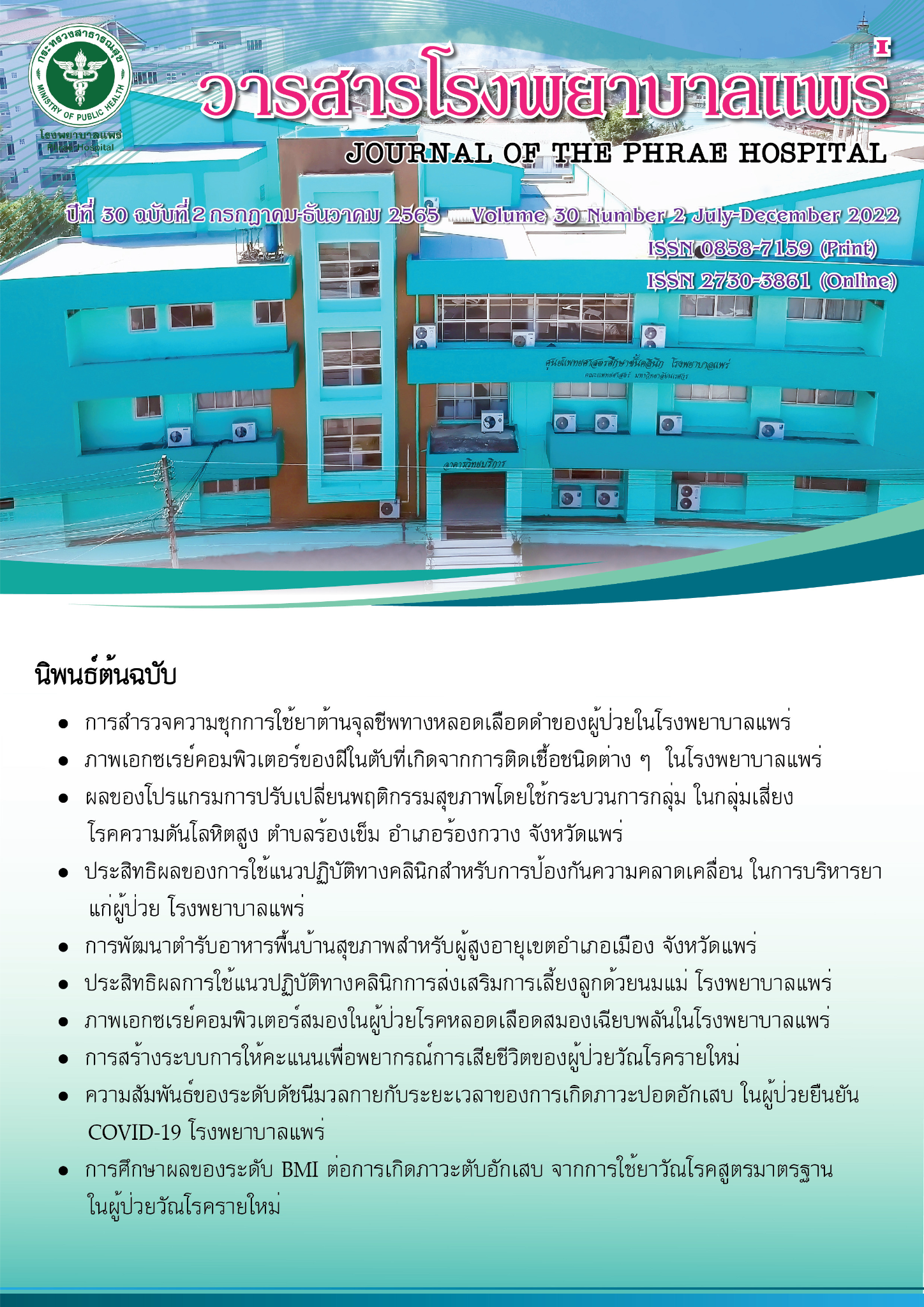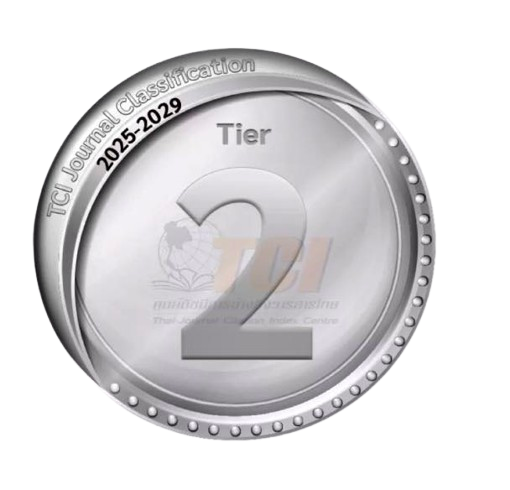ประสิทธิผลการใช้แนวปฏิบัติทางคลินิกการส่งเสริมการเลี้ยงลูกด้วยนมแม่ โรงพยาบาลแพร่
คำสำคัญ:
Clinical practice guidelines, Breastfeedingบทคัดย่อ
บทนำ: อัตราการเลี้ยงลูกด้วยนมแม่อย่างเดียวอย่างน้อย 6 เดือนหลังคลอด มีแนวโน้มลดลงและบุคลากรมีแนวทางปฏิบัติการส่งเสริมการเลี้ยงลูกด้วยนมแม่ที่หลากหลาย ซึ่งการส่งเสริมให้มารดาประสบความสำเร็จในการเลี้ยงลูกด้วยนมแม่ต้องจัดการส่งเสริมอย่างต่อเนื่องตั้งแต่ระยะตั้งครรภ์ คลอด จนถึงระยะหลังคลอด ซึ่งแนวปฏิบัติการพยาบาลการส่งเสริมการเลี้ยงลูกด้วยนมแม่โรงพยาบาลแพร่ ที่พัฒนาขึ้นอาจเพิ่มอัตราการเลี้ยงลูกด้วยนมแม่อย่างเดียวในระยะก่อนจำหน่าย และอัตราการเลี้ยงลูกด้วยนมแม่อย่างเดียวในระยะ 6 เดือนได้
วัตถุประสงค์: เปรียบเทียบอัตราการเลี้ยงลูกด้วยนมแม่อย่างเดียวในระยะก่อนจำหน่าย และระยะ 6 เดือนหลังคลอด ในมารดาหลังคลอดที่ได้รับการส่งเสริมตามแนวปฏิบัติทางคลินิกการส่งเสริมการเลี้ยงลูกด้วยนมแม่ โรงพยาบาลแพร่ กับกลุ่มที่ได้รับการดูแลตามปกติ
วิธีการศึกษา: การวิจัยกึ่งการทดลอง (Qua-si experimental) ในหญิงตั้งครรภที่อายุตั้งแต่ 20 ปีขึ้นไป อายุครรภ์ตั้งแต่ 32 สัปดาห์ขึ้นไปที่มาฝากครรภ์คลอดครบกำหนด รวมทั้ง พักการรักษาตัวระยะหลังคลอด และติดตามการเลี้ยงลูกด้วยนมแม่ในคลินิกนมแม่ โรงพยาบาลแพร่จนครบ 6 เดือนหลังคลอด ในระหว่าง เดือน มีนาคม 2564–กุมภาพันธ์ 2565 วิเคราะห์ข้อมูลโดยใช้สถิติเชิงพรรณา การแจกแจงความถี่ ร้อยละ และสถิติ t-test
ผลการศึกษา: ทั้งสองกลุ่มส่วนใหญ่ไม่มีประสบการณ์การเลี้ยงดูเด็ก กลุ่มทดลองมีระดับการไหลของน้ำนมเกรด 3 ร้อยละ100 ส่วนกลุ่มควบคุมส่วนใหญ่น้ำนมไหลเกรด 3 ร้อยละ 57.9 และกลุ่มทดลองมีระดับ คะแนน LATCH ก่อนจำหน่ายเฉลี่ย 8.47 คะแนน กลุ่มควบคุมเฉลี่ย 8.21 คะแนนกลุ่มทดลอง และกลุ่มควบคุมมีอัตราการเลี้ยงลูกด้วยนมแม่ในระยะ 24 ชั่วโมง ก่อนจำหน่ายร้อยละ 84.2 และ 60.5 ตามลำดับ ส่วนในระยะ 6 เดือนหลังคลอดกลุ่มทดลองเลี้ยงลูกด้วย นมแม่อย่างเดียวร้อยละ 68.4 ส่วนกลุ่มควบคุมเลี้ยงลูกด้วยนมแม่อย่างเดียวร้อยละ 42.1
สรุป: แนวปฏิบัติทางคลินิกการส่งเสริมการเลี้ยงลูกด้วยนมแม่ โรงพยาบาลแพร่ สามารถทำให้มารดาประสบความสำเร็จในการเลี้ยงลูกด้วยนมแม่ และช่วยเพิ่มอัตราการเลี้ยงลูกด้วยนมแม่อย่างเดียวในระยะ 24 ชั่วโมงก่อนจำหน่าย และระยะ 6 เดือนหลังคลอดได้
ความสำคัญ: แนวปฏิบัติทางคลินิก, การเลี้ยงลูกด้วยนมแม่
เอกสารอ้างอิง
Victora CG, Bahl R, Barros AJD, França GVA, Horton S, Krasevec J, et al. Breastfeeding in the 21 st century: epidemiology, mechanisms, and life- long effect. Lancet 2016;387:475–90.
Chowdhury R, Sinha B, Sankar MJ, Taneja S, Bhandari N, Rollins N, et al. Breastfeeding and maternal health outcomes: a systematic review and meta-analysis. Acta Pædiatrica 2015;104(467):96–113.
Walters D, Horton S, Siregar AYM, Pitriyan P, Hajeebhoy N, Mathisen R, et al. The cost of not breastfeeding in Southeast Asia. Health Pol Plann 2016;31(8):1107–16.
สำนักงานสถิติแห่งชาติ. การสำรวจเด็กและ สตรีในประเทศไทย พ.ศ. 2555 รายงานฉบับสมบูรณ์ (MICS 4). กรุงเทพฯ: สำนักงานสถิติแห่งชาติ; 2556.
สำนักงานสถิติแห่งชาติ. การสำรวจเด็กและ สตรีในประเทศไทย พ.ศ. 2558-9 รายงานฉบับสมบูรณ์ (MICS 5). กรุงเทพฯ: สำนักงานสถิติแห่งชาติ; 2559.
พัตธนี วินิจจะกูล, อรพร ดำรงวงศ์ศิริ. สถานการณ์การเลี้ยงลูกด้วยนมแม่ ปัจจัยเอื้อและอุปสรรค นโยบายและมาตรการส่งเสริมการเลี้ยงลูกด้วยนมแม่ในประเทศไทย. วารสารโภชนาการ 2563;55(1):66-81.
สุดาภรณ์ พยัคฆเรือง, พรรณรัตน์ แสงเพิ่ม, ชญาดา สามารถ. ปัญหาการเลี้ยงลูกด้วยนมแม่ระยะแรกหลังคลอด: ประสบการณ์ของมารดา. พยาบาลสาร 2559;34(3):30-40.
Sinha B, Chowdhure R, Sankar MJ, Martines J, Taneja S, Mazumder S, et al. Interventions to improve breastfeeding outcomes: a systema- tic review And meta-analysis. Acta Pædiatrica 2015;104:114–35.
Thephaj T, Marais D, Bell J, Muangpin S. Facilitators and Barriers to Exclusive Breastfeeding in Thailand: A Narrative Review. Journal of Community and Public Health Nursing 2013;3(1):1-9.
โรงพยาบาลแพร่. สถิติหอผู้ป่วยหลังคลอดโรงพยาบาลแพร่ ประจำปี 2563. แพร่: โรงพยาบาลแพร่; 2563.
ฉวีวรรณ ธงชัย. การพัฒนาแนวปฏิบัติทางคลินิก. วารสารสภาการพยาบาล 2548;20(2):63-6.
สุนิสา ปัทมาภรณ์พงศ์, ทิพาพรรณ คำห้าง, สิรินธร สงวนเจียม. การพัฒนาแนวปฏิบัติทางคลินิกการส่งเสริมการเลี้ยงลูกด้วยนมแม่ โรงพยาบาลแพร่. แพร่: โรงพยาบาลแพร่; 2563.
สุนิสา ปัทมาภรณ์พงศ์, ทิพาพรรณ คำห้าง, สิรินธร สงวนเจียม, กรรณิกา ฤทธิสินธุ์, มะลิ คมแหลม. ประสิทธิผลการใช้แนวปฏิบัติทางคลินิกเพื่อส่งเสริมการเลี้ยงลูกด้วยนมแม่ในมารดาวัยรุ่น โรงพยาบาลแพร่. วารสารโรงพยาบาลแพร่ 2554;19(2):59-69.
National Health and Medical Research Council [NHMRC]. A guideline to the development, implementation and evaluation of clinical practice guideline. 1999 [cited 2018 Feb 8]. Available from: https://www.nhmrc.gov.au/_ files_nhmrc/publications/attachments/cp 30.pdf.
UNICEF & Word Health Organization. Enabling Women to Breastfeed Trough Better Policies and Programmes; Global Breastfeeding Scorecard. 2018 [cited 2018 Feb 8]. Available from: https://www.who.int/nutria tion/publications/infantfeeding/global-bf-scorecard-2018.pdf?ua=1 (2018)
Radzyminski S, Callister CL. Mother’s Beliefs, Attitudes, and Decision Making Related to Infant Feeding Choices. The Journal of Perinatal Education 2016;25(1):18–28.
Brasil Esteves TM, Daumas R, Couto de Oliveira MI, Ferreira de Andrade CA, Leite IC. Factors associated to breastfeeding in the first hour of life: Systematic review. Revista de Saude Publica 2014);48(4):697-708.
Permatasari T, Syafruddin A. Early Initiation of Breastfeeding Related to Exclusive Breastfeeding and Breastfeeding Duration in Rural and Urban Areas in Subang, West Java, Indonesia. J Health Res 2016;30(5): 337-45.
Inano H, Kameya M, Sasano K, Matsumura K, Tsuchida A, Hamazaki K, et al. Factors infuencing exclusive breastfeeding rates until 6 months postpartum: the Japan Environment and Children’s Study. Sci Rep (2021);11(1):6841. doi:10.1038/s415 98 -021-85900-4.
Rana MM, Islam MR, Karim MR, Islam AZ, Akramul HM, Shahiduzza- man, et al. Know-ledge and practices of exclusive breastfeeding among mothers in rural areas of Rajshahi district in Bangladesh: A community clinic based study. PLoS One 2020; 15(5):e0232027. doi: 10.1371/journal. pone.0232027.
Ali Aldalili AY, El.Mahalli AA. Research Title: Factors Associated with Cessation of Exclusive Breast feeding. J Multidiscip Healthc 2021;14:239–46.
Ketbi MIA , Noman SA , Ali AA, Darwish E. Knowledge, attitudes, and practices of breastfeeding among women visiting primary healthcare clinics on the island of Abu Dhabi, United Arab Emirates. International Breast- feeding Journal 2018;13(1):1-14.
Jensen D, Wallace S, Kelsay P. LATCH: a breastfeeding charting system and documentation tool. J Obstet Gynecol Neonatal Nurs 1994;23(1):27-32. doi: 10.1111/j.1552-6909.1994.tb 01847.x.
Shah MH, Roshan R, Parikh T, Sathe S, Vaidya U, Pandit A. LATCH Score at Discharge: A Predictor of Weight Gain and Exclusive Breastfeeding at 6 Weeks in Term Healthy Babies. J Pediatr Gastroenterol Nutr 2021;72(2):e48-e52. doi:10.1097/MPG.00000000 00002927.
Ramiro González MD, Marrón HO, Argüelles Canedo CA, Espraza Olcina MJ, Claramonteet MT, et al. Prevalence of breastfeeding and factors associated with the start and duration of exclusive breast feeding in the Community of Madrid among participants in the ELOIN. Anales de Pediatría (English Edition) 2018;89(1):31-43.





